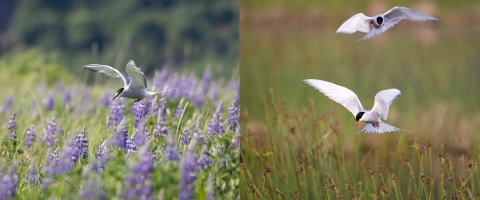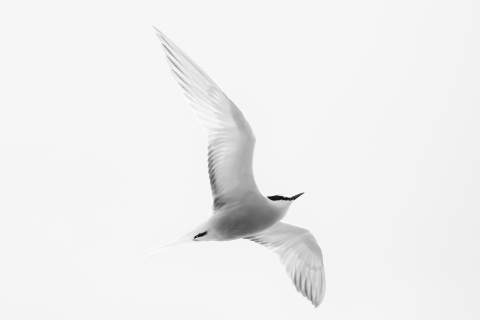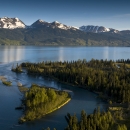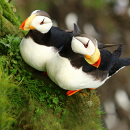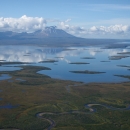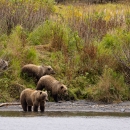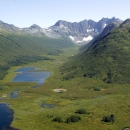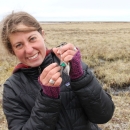States
AlaskaEcosystem
CoastalAleutian terns: a legendary flier and lesser-known cousin of the Arctic Tern
If you have spent time in the summer along the coastline of Alaska, chances are you’ve encountered a tern. Terns are graceful, pale grey seabirds that float between land and water, hovering and diving for small fish. Tern species in Alaska have long narrow wings, forked tails, and black caps.
Take a closer look next time you see one: does the bird have a white forehead? Does it have a black or a red beak and legs?
If red, you are probably looking at an Arctic tern, legendary for the longest migration of any bird between the far reaches of the southern and northern hemispheres.
If the beak and legs are black, and you spy a white forehead under that black cap, you may have encountered a lesser-known tern that breeds only in Alaska and Russia: the Aleutian tern. For birds in flight, look for the black trailing edge of the Aleutian tern’s secondary feathers.
Perhaps you will even see Aleutian and Arctic terns side-by-side, as this seabird often nests in or near Arctic tern colonies. Do you hear the birds calling? The Aleutian tern’s call has been described by one of our species experts as soft and sweet, almost finch-like. Compare this to the harsh, grating calls of an Arctic tern.
Even in Alaska, Aleutian terns are much rarer than Arctic terns. This tern takes a unique migratory path to and from Alaska: after the nesting season, the Aleutian tern wings its way along the thousand-mile Aleutian Island chain before reaching the Yellow Sea and taking a sharp left turn, down the coastline of China and southeast Asia to winter in Indonesia and the Philippines.
The Aleutian tern needs our help
While their numbers may possibly be stable in Russia, Aleutian tern numbers in Alaska appear to have plummeted since the 1960s.
The Aleutian tern is considered a Bird of Conservation Concern / Species of Greatest Conservation Need in Alaska because of its declining numbers and the lack of information about its population. Recently, the International Union for Conservation of Nature (IUCN) classified the Aleutian tern as “vulnerable” because of these rapid declines.
Alaskan communities play a vital role in conserving the Aleutian tern
Ways you can help:
- Watch out for nests near beaches. Aleutian terns particularly like to nest in grassy, flat areas above the high tide line. If you see terns hovering over land or if a tern warns you away, you are probably near a nest or mobile chicks. Be aware tern nests may just be depressions in the ground with well-camouflaged eggs. Take care and give the birds, their nests, and their chicks space.
- Respect the tern’s need for undisturbed locations to nest and raise their young. Avoid walking through nesting habitat. Even one-time disturbance can result in loss of eggs and chicks, and repeated disturbance can lead to permanent colony abandonment.
- Sometimes, wildlife managers install signs and fences around known nesting colonies in busy areas. Watch out for signs and remain outside fenced areas.
- It’s ok to observe and photograph terns! Make sure to give the colony plenty of space and try to stay in one spot so you minimize potential for birds to notice you and flush.
- Please make sure to leash your dogs when near tern colonies, to help the birds nest successfully! Unleashed dogs can unintentionally flush birds and damage nests, and curious dogs may cause loss of eggs and chicks.
- Reduce plastic use. Terns and other seabirds mistake plastics for food in the ocean. Commit to reusable bags, fillable water bottles, and overall reducing plastics purchased.
- Discard monofilament fishing line and other garbage in covered bins to reduce the risk of terns and other birds becoming entangled on our beaches and in our waterways.
Help us learn more about Aleutian tern populations! These birds are difficult to track over time because they occasionally move their colonies, especially when they have experienced disturbance. While we have collected information over many years from known colony sites, this species is rare in a vast landscape, and there may be changes at colonies we haven’t known about or monitored.
You can report colony locations and any observations about changes in population to: ak_mbm@fws.gov AND/OR ak_fisheries@fws.gov. A subject line like “Aleutian tern sighting” can help direct your report to the correct individual. Please be patient with us if we don’t respond quickly. We might be out surveying for terns!
By getting involved, you can help protect the Aleutian tern and ensure it thrives for future generations. There are many ways to contribute, from participating in local bird counts and being a steward of local beaches to spreading awareness about the tern's plight. Schools, families, and local organizations can work together to support research and conservation efforts. By joining forces, we can create a safer Alaskan home for the Aleutian tern. Your efforts make a difference—let's protect our wildlife together!
Aleutian tern research and monitoring
Aleutian terns represent more than a seabird species in decline. They also alert us to changes in the overall health of ocean ecosystems. Identifying why they are in trouble can give us clues about local marine food webs and impacts to marine systems all along their migratory routes.
Formation of Aleutian tern working groups
Worried about the Aleutian tern's declining population, in 2007 a group of seabird experts formed the Aleutian Tern Working Group to explore what information we need to help these birds. Multiple U.S. Fish and Wildlife Service Programs have actively participated in the Working Group, together with partners, since its inception.
In 2016, the Working Group rolled into a formalized Aleutian Tern Technical Committee (ATTC). The ATTC’s broad membership includes researchers with an interest in Aleutian tern conservation, from different federal and state agencies, universities, and non-profit organizations from across the species’ global range.
Collaborative research and a comprehensive state-wide survey
Aleutian tern experts have been working together, through the ATTC and the Aleutian Tern Working Group, to identify knowledge gaps and prioritize research needed to more proactively manage and conserve this species. Updating the population estimate for Aleutian terns in Alaska was identified as a high priority.
- 2018-2020: Testing survey methods
In January 2018, the ATTC held their first meeting in Anchorage, Alaska, to figure out the best ways to count Aleutian terns. They tested four different methods during the 2018 and 2019 field season: ground-based counts of flying birds, photos from the ground, low altitude drone photos, and using sound recordings with nest counts. In May 2020, a third meeting helped refine these methods for wider use. - 2021: Pilot survey
Biologists conducted a "pilot survey” during the 2021 breeding season to test the new methods. This work helped prepare for a more extensive statewide survey. - 2023: 3-year State-wide Survey begins
Partners began the first year of a comprehensive statewide survey focused on potential nesting areas along the coast of Alaska, using both aerial and ground methods. The U.S. Forest Service played a major role in 2023, with the survey covering Southeast Alaska. The National Park Service supported the survey at the southern extent of the species’ range, which overlaps Glacier Bay National Park and Preserve. - What's next? 2024-2025: Surveying the remaining coast, including potential habitat in nine wildlife refuges
The U.S. Fish and Wildlife Service plays a major role in the 2024 and 2025 surveys for coastal areas of the Kenai and Alaska Peninsulas, Bristol Bay, and Western and Northwest Alaska. The survey route includes coastline along nine of Alaska’s 16 National Wildlife Refuges: Alaska Maritime, Alaska Peninsula, Becharof, Izembek, Kenai, Kodiak, Selawik, Togiak, and Yukon Delta Refuges.
How we survey
The Statewide Aleutian Tern Survey uses a combination of aerial surveys and ground counts of Aleutian tern nesting colonies. Aerial surveys are designed to locate tern colonies (both Aleutian and Arctic terns) within the study area. It is immensely difficult for aerial observers to accurately count terns associating with a colony, or to distinguish between tern species from moving aircraft. Therefore, following aerial surveys, biologists will access tern colonies on the ground, to identify and count birds present at the colonies.
Low-level Aerial Surveys: Our surveys will occur during June and part of July, the time of year when Aleutian terns are incubating eggs in their nesting colonies. Using fixed-wing aircraft, we will fly transects along the coast of Alaska to locate tern colonies up to 3.7 mi (6 km) inland. A pilot and two to three observers will search for low-flying terns, especially terns flying with fish, and terns on the ground. While searching for nesting colonies, aircraft will fly at 500 ft (152 m) above ground level.
Ground Surveys: Our ground survey crews will visit as many tern colonies detected from the air as time and weather allow. Ground surveyors will use cars, helicopters, fixed-wing aircraft, and boats as transportation. Once close to a colony location identified by the aerial survey crew, they will hike to a good viewing point that will let them count terns and identify species. At least two observers will independently count terns at the colony, three times per observer to get the best counts of Aleutian and Arctic terns we can.
The 2024 survey area will include the coastline and selected islands of Cook Inlet and the coastline and selected islands of Bristol Bay and the Alaska Peninsula.
Aleutian Tern Working Group collaborators
Within the ATTC, the Aleutian Tern Working Group has continued collaborative efforts to study the Aleutian tern.
In addition to programs within the U.S. Fish and Wildlife Service, active collaborators include:
Prince William Sound Science Center (Anne Schaefer, Aleutian Tern Survey Coordinator)
Oregon State University/Audubon Seabird Institute
McDonald Data Sciences
Tern Again Consulting

